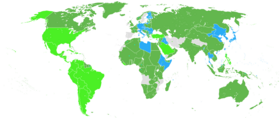The Axis powers (German: Achsenmächte, Japanese: 枢軸国 Sūjikukoku, Italian: Potenze dell'Asse), also known as the Axis, were the nations that fought in the Second World War against the Allied forces. The Axis powers agreed on their opposition to the Allies, but did not coordinate their wars.
The Axis grew out of the diplomatic efforts of Germany, Italy and Japan to secure their own specific expansionist interests in the mid-1930s. The first step was the treaty signed by Germany and Italy in October 1936. Mussolini declared on November 1 that all other European countries would from then on rotate on the Rome-Berlin axis, thus creating the term "Axis".
The almost simultaneous second step was the signing in November 1936 of the Anti-Comintern Pact, an anti-communist treaty between Germany and Japan. Italy joined the Pact in 1937. The "Rome–Berlin Axis" became a military alliance in 1939 under the so-called "Pact of Steel", with the Tripartite Pact of 1940 leading to the integration of the military aims of Germany and its two treaty-bound allies.
At its zenith during World War II, the Axis presided over territories that occupied large parts of Europe, North Africa, and East Asia. There were no three-way summit meetings and cooperation and coordination was minimal, with a bit more between Germany and Italy. The war ended in 1945 with the defeat of the Axis powers and the dissolution of their alliance.
As in the case of the Allies, membership of the Axis was fluid, with some nations switching sides or changing their degree of military involvement over the course of the war.
--------------------------------------------------------------
--------------------------------------------------
The management of the Axis countries
Norway, occupied
Denmark, occupied, signed Antikomintern Agreement 1941
The Netherlands, occupied
Belgium, occupied
Vichy France (August 1944)
------------------------------------------
Countries in managing their Axis powers, who participated in military action:
Independent State of Croatia
Siam (now Thailand)
Slovakia
Serbia
Montenegro
Slovakia 1941
Serbia 1941-1944
Montenegro during
--------------------------------------------
Unbiased countries that had good relations with the axis powers:
Argentina (finally declared war on Germany, under pressure from the US, and Japan, of 27 March 1945)
Spain
Portugal (held the same time as the secular Association of Great Britain)
Sweden (it was towards the end of the war heeled Allied side)
Switzerland (inter alia, took the German Messerschmitt Bf 109 fighters)
Turkey (from Germany took against the military material, and hitting it with the trade)
------------------------------------------------
Akselivallat oli toinen toisen maailmansodan osapuolista. Se taisteli liittoutuneita vastaan.
Akselivallat-termi syntyi 25. lokakuuta 1936 allekirjoitetusta Berliinin–Rooman akseliksi kutsutusta liitosta Saksan ja Italian välillä. Nimitystä käytti Benito Mussolini 1. marraskuuta 1936 pitämässään puheessa. Japani liittyi akselivaltoihin Antikomintern-sopimuksella kuukautta myöhemmin.
22. toukokuuta 1939 Berliinin–Rooman akseli muutettiin liittosopimukseksi, jota kutsuttiin terässopimukseksi.Liitto laajennettiin kolmen vallan sopimukseksi 27. syyskuuta 1940 Berliinissä. Se virallisti liittosuhteen ja varoitti Yhdysvaltoja liittymästä sotaan. Kolmen vallan sopimukseen liittyivät myös Unkari (20. marraskuuta 1940), Romania (23. marraskuuta 1940) ja Bulgaria (1. maaliskuuta 1941).
Neuvostoliitto solmi Saksan kanssa hyökkäämättömyyssopimuksen Moskovassa 23. elokuuta 1939. Sopimus oli Antikomintern-sopimuksen vastainen, ja Japani vetäytyi vastalauseena. Sopimuksen salainen lisäpöytäkirja sisälsi jaon, jossa Itä-Eurooppa jäi Saksan ja Neuvostoliiton etupiireihin. Sopimuksen neutraalisuuspykälän vuoksi Saksa pysäytti Italian Suomelle talvisotaan lähettämän avun.
Antikomintern-sopimus elvytettiin vuonna 1941 Saksan hyökättyä Neuvostoliittoon. Siihen liittyivät lopulta Saksa, Japani, Italia, Unkari, Espanja, Mantšukuo, Bulgaria, Kroatia, Tanska, Suomi, Romania, Slovakia ja Nanjingin hallitus Kiinassa.
Jugoslavian kuningaskunnan valtionhoitaja ruhtinas Pavle allekirjoitti kolmen vallan sopimuksen 25. maaliskuuta 1941 Wienissä, mutta maassa tapahtui vallankaappaus kolme päivää myöhemmin Ison-Britannian tuella. Tämän seurauksena Jugoslavia ja Kreikka joutuivat miehitetyiksi kesällä 1941. Tämän jälkeen äärioikeistolainen Ustaša julisti Itsenäisen Kroatian valtion osassa miehitettyä Jugoslaviaa, johtajanaan Ante Pavelić.
Italian sosiaalinen tasavalta (Salòn tasavalta) perustettiin 1943 Italian antauduttua liittoutuneille. Saksalaiset kommandot vapauttivat vangitun Benito Mussolinin, joka nousi saksalaisten tuella valtaan Pohjois-Italiassa pääkaupunkinaan Salò.
---------------------------------------------------------------
| Axis powers | ||||||||||||
| Achsenmächte 枢軸国 Potenze dell'Asse | ||||||||||||
| Military alliance xxxxxxxxxxxxxxxxxxxxxxxxxxxxxx
| ||||||||||||
| ||||||||||||
Client states:
| ||||||||||||
German military forces of foreign legions
- Armenia
- Azerbaijan
- Azerbaijan
- Belarus
- Don
- Don cossacks
- Estonia
- Georgia
- Kalmuks
- Kaminsky's prigate
- Kaukasus
- Kuban
- Kuban cossacks
- Latvians
- Lithuanian
- Turkestan
- Terek cossacks
- Ukraina
- Volga tatars
xxxxxxxxxxxxxxxxxxxxxxxxxxxxxxxxxxxxxxxxxxxxxxxxxxxxx
German military forces of foreign armed forces emblem patches
Belgium
Bulgarian
Crimean Tatars
Croatian
Danish
Finnish
Flanders
French
Hungarian
India (Gurkha is the Allied side)
Italian
Netherlands
North African Arabs
Romanian
Russian
Slovak
Spanish
Siberian Cossacks
Turkestan
Subhas Chandra Bose
German military forces of foreign armed forces emblem patches
Belgium
Bulgarian
Crimean Tatars
Croatian
Danish
Finnish
Flanders
French
Hungarian
India (Gurkha is the Allied side)
Italian
Netherlands
North African Arabs
Romanian
Russian
Slovak
Spanish
Siberian Cossacks
Turkestan
Subhas Chandra Bose

Ei kommentteja:
Lähetä kommentti
Any explosive ammunition or empty cores, you can put in this.